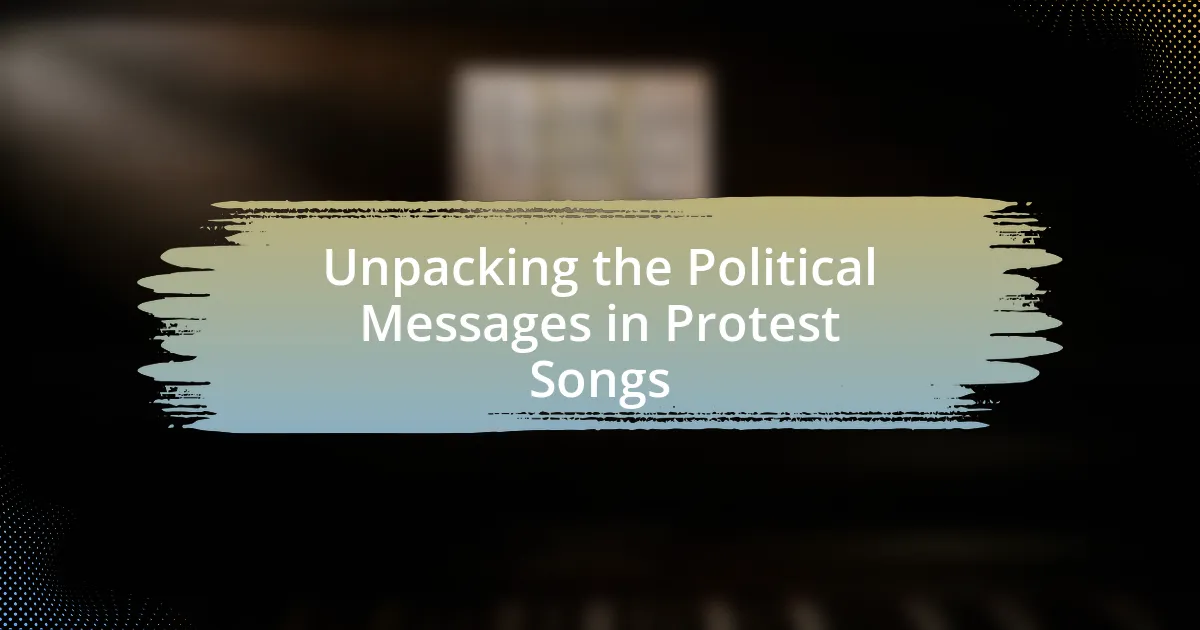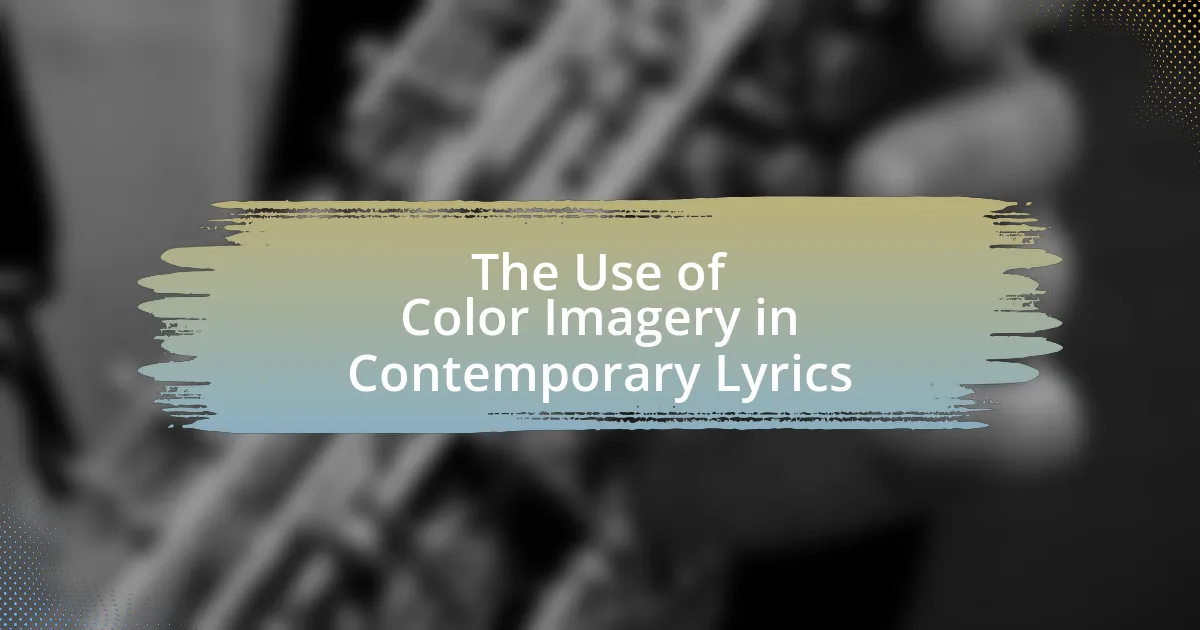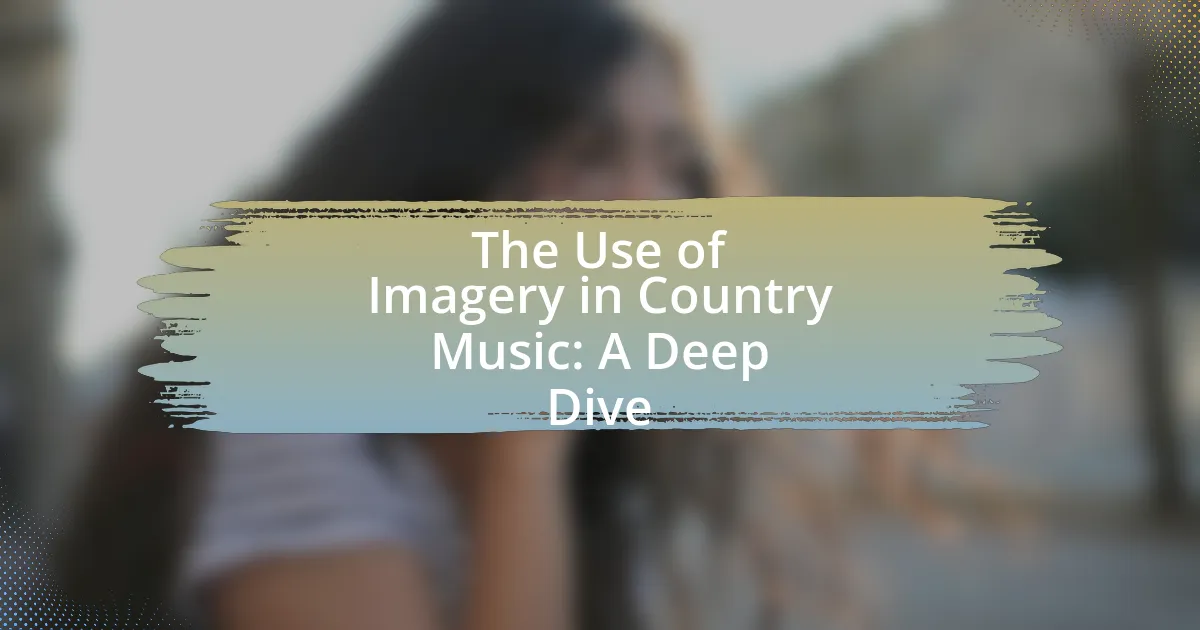The article explores the narrative techniques employed by Taylor Swift in her storytelling, highlighting key elements such as vivid imagery, personal anecdotes, and nonlinear timelines. It examines how Swift’s use of first-person perspective creates an intimate connection with listeners, enhancing emotional engagement and relatability. The article also discusses the impact of her autobiographical content on her songwriting, the role of imagery in crafting vivid scenes, and the structured narrative arcs present in her music. Additionally, it compares Swift’s techniques to those of other artists, emphasizing her unique approach to personal storytelling and its implications for her public persona and brand identity.

What are the key narrative techniques used in Taylor Swift’s storytelling?
Taylor Swift employs several key narrative techniques in her storytelling, including vivid imagery, personal anecdotes, and nonlinear timelines. Vivid imagery allows listeners to visualize scenes and emotions, enhancing the relatability of her songs. Personal anecdotes draw from her own experiences, creating authenticity and emotional depth, as seen in tracks like “All Too Well,” where she recounts specific memories. Nonlinear timelines are utilized to weave together past and present narratives, allowing for complex storytelling that engages listeners, as demonstrated in songs like “The Archer.” These techniques collectively contribute to her distinctive storytelling style, making her music resonate on a personal level with a wide audience.
How does Taylor Swift utilize first-person perspective in her lyrics?
Taylor Swift utilizes first-person perspective in her lyrics to create an intimate connection with her audience. This narrative technique allows her to express personal emotions and experiences, making her storytelling relatable and engaging. For instance, in songs like “All Too Well,” Swift recounts specific memories and feelings, drawing listeners into her personal narrative. The use of “I” and “you” in her lyrics enhances the emotional depth, allowing fans to feel as though they are part of her journey. This approach has been a hallmark of her songwriting, contributing to her widespread appeal and critical acclaim.
What impact does first-person narration have on listener engagement?
First-person narration significantly enhances listener engagement by creating a personal connection between the narrator and the audience. This narrative style allows listeners to experience the story through the narrator’s perspective, fostering empathy and emotional investment. Research indicates that first-person accounts can lead to higher levels of identification with characters, as evidenced by studies showing that audiences are more likely to relate to and remember stories told from a first-person viewpoint. In Taylor Swift’s storytelling, this technique effectively draws listeners into her experiences, making her music resonate on a deeper emotional level.
How does this perspective shape the emotional depth of her songs?
Taylor Swift’s perspective, rooted in personal experiences and vivid storytelling, significantly enhances the emotional depth of her songs. This perspective allows her to convey relatable themes of love, heartbreak, and self-discovery, resonating deeply with listeners. For instance, in songs like “All Too Well,” Swift employs detailed imagery and specific anecdotes, which evoke strong emotional responses and create a sense of intimacy. Her ability to articulate complex feelings through narrative techniques, such as character development and chronological storytelling, further enriches the emotional landscape of her music, making her songs not only relatable but also profoundly impactful.
What role does imagery play in Taylor Swift’s songwriting?
Imagery plays a crucial role in Taylor Swift’s songwriting by creating vivid mental pictures that enhance emotional connection and storytelling. Swift employs descriptive language and sensory details to evoke specific feelings and settings, allowing listeners to immerse themselves in the narrative. For instance, in songs like “All Too Well,” she uses imagery to paint a detailed scene of a past relationship, making the emotions more relatable and impactful. This technique not only enriches the lyrical content but also engages the audience’s imagination, making her stories resonate on a deeper level.
How does Swift use descriptive language to create vivid scenes?
Swift employs descriptive language to create vivid scenes by utilizing detailed imagery and sensory details that evoke strong emotions. For instance, in her song “All Too Well,” she paints a picture of a past relationship through specific visual elements, such as “the scarf” and “the kitchen,” which allow listeners to visualize the setting and feel the nostalgia. This technique enhances the emotional impact of her storytelling, making the experiences relatable and immersive. By incorporating precise descriptions and emotional resonance, Swift effectively transports her audience into the scenes she depicts, reinforcing the authenticity of her narratives.
What are some examples of powerful imagery in her lyrics?
Taylor Swift’s lyrics often feature powerful imagery that evokes strong emotions and vivid scenes. For instance, in “All Too Well,” she describes a scarf left behind, symbolizing lost love and nostalgia, creating a visual representation of memories tied to a relationship. In “The Last Great American Dynasty,” she paints a picture of a woman who disrupts societal norms, using imagery of a lavish mansion and the gossip surrounding it to illustrate themes of legacy and judgment. Additionally, in “Blank Space,” Swift employs imagery of a romantic relationship as a dangerous game, using metaphors of fire and ice to convey passion and volatility. These examples demonstrate her ability to craft detailed and evocative scenes that resonate with listeners.
How does Taylor Swift incorporate storytelling arcs in her music?
Taylor Swift incorporates storytelling arcs in her music by crafting songs that follow a clear narrative structure, often featuring character development, conflict, and resolution. For instance, in her album “Red,” the song “All Too Well” presents a vivid recollection of a past relationship, detailing emotional highs and lows, which allows listeners to engage with the story on a personal level. This technique is supported by her use of specific imagery and relatable themes, such as heartbreak and nostalgia, which resonate widely with her audience. Additionally, Swift often employs a chronological progression in her lyrics, guiding listeners through the unfolding of events, thereby enhancing the storytelling experience.
What are the common elements of a narrative arc present in her songs?
The common elements of a narrative arc present in Taylor Swift’s songs include exposition, rising action, climax, falling action, and resolution. In her storytelling, Swift often introduces characters and settings in the exposition, builds tension through rising action with conflicts or emotional struggles, reaches a climax where pivotal moments occur, and concludes with falling action and resolution that reflect on the experiences shared. For example, in “Love Story,” the narrative arc follows a classic structure where the initial conflict of forbidden love is introduced, leading to a climactic moment of resolution that emphasizes hope and reconciliation. This structured approach allows listeners to engage deeply with the emotional journeys depicted in her music.
How do these arcs enhance the overall message of her music?
The arcs in Taylor Swift’s music enhance the overall message by providing depth and emotional resonance to her storytelling. These narrative arcs allow listeners to connect with her experiences, illustrating themes of love, heartbreak, and personal growth. For instance, the progression from innocence to experience in songs like “Love Story” to “All Too Well” showcases her evolution as an artist and individual, reinforcing the message that personal narratives are complex and multifaceted. This technique not only engages the audience but also emphasizes the relatability of her lyrics, making her music impactful and memorable.

In what ways does Taylor Swift’s storytelling reflect her personal experiences?
Taylor Swift’s storytelling reflects her personal experiences through autobiographical lyrics that detail her relationships, emotions, and life events. For instance, her song “All Too Well” vividly recounts a past relationship, incorporating specific memories and feelings that resonate with listeners, showcasing her ability to transform personal pain into relatable narratives. Additionally, Swift often uses her own life milestones, such as her transition from adolescence to adulthood, as thematic backdrops in albums like “Fearless” and “Lover,” which explore growth and self-discovery. This approach not only personalizes her music but also invites fans to connect with her experiences on a deeper level, reinforcing the authenticity of her storytelling.
How does autobiographical content influence her songwriting?
Autobiographical content significantly influences Taylor Swift’s songwriting by providing authentic emotional depth and relatability. Swift often draws from her personal experiences, relationships, and challenges, which allows her to create narratives that resonate with her audience. For instance, her album “Red” features songs that reflect her real-life heartbreaks and friendships, showcasing her ability to transform personal stories into universal themes. This approach not only enhances the emotional connection with listeners but also establishes her as a credible storyteller in the music industry.
What themes of personal growth and reflection are evident in her work?
Themes of personal growth and reflection evident in Taylor Swift’s work include self-discovery, resilience, and the complexities of relationships. Swift’s lyrics often explore her journey through various life stages, showcasing her evolution from adolescence to adulthood. For instance, in songs like “Clean,” she reflects on overcoming past struggles and emerging stronger, illustrating her resilience. Additionally, tracks such as “The Archer” delve into introspection, highlighting her vulnerabilities and the quest for self-acceptance. These themes resonate with listeners, as they encapsulate universal experiences of growth and self-reflection.
How does Swift balance personal narrative with universal themes?
Taylor Swift balances personal narrative with universal themes by intertwining her individual experiences with relatable emotions and situations that resonate with a broad audience. For instance, in songs like “All Too Well,” Swift details a specific relationship while simultaneously addressing themes of heartbreak and nostalgia that many listeners can identify with. This technique allows her to create a connection between her unique stories and the shared human experience, making her music both personal and universally appealing.
What are the implications of her storytelling on her public persona?
Taylor Swift’s storytelling significantly shapes her public persona by creating a relatable and authentic image. Through her lyrics and narratives, she connects with her audience on personal levels, often sharing intimate experiences that resonate with listeners. This approach fosters a sense of community among fans, as they see their own stories reflected in her music. Additionally, her storytelling often addresses themes of love, heartbreak, and personal growth, which enhances her appeal as an artist who is both vulnerable and resilient. This duality in her narrative style contributes to a multifaceted public persona that is perceived as genuine and approachable, ultimately solidifying her status as a cultural icon.
How does her narrative style contribute to her brand identity?
Taylor Swift’s narrative style significantly contributes to her brand identity by creating a relatable and authentic connection with her audience. Her use of personal storytelling, vivid imagery, and emotional honesty allows listeners to see their own experiences reflected in her music, fostering a sense of intimacy and loyalty. For instance, songs like “All Too Well” showcase detailed storytelling that resonates deeply with fans, enhancing her image as a genuine artist who shares her life experiences. This approach not only differentiates her in the music industry but also solidifies her brand as one that values vulnerability and connection.
What reactions do fans have to her personal storytelling approach?
Fans generally react positively to Taylor Swift’s personal storytelling approach, appreciating its authenticity and emotional depth. Many fans express that her lyrics resonate with their own experiences, creating a strong connection between her music and their lives. This connection is often highlighted in social media discussions, where fans share personal anecdotes that align with the themes in her songs, demonstrating the impact of her storytelling on their emotional well-being. Additionally, her ability to weave personal narratives into broader themes of love, heartbreak, and growth is frequently praised, as it allows listeners to find solace and understanding in her work.

How do Taylor Swift’s narrative techniques compare to those of other artists?
Taylor Swift’s narrative techniques are characterized by personal storytelling and vivid imagery, which often set her apart from other artists. Unlike many contemporary musicians who may rely on abstract themes or generalized emotions, Swift employs specific anecdotes and detailed character development, allowing listeners to connect deeply with her experiences. For instance, her song “All Too Well” features intricate storytelling that captures a specific moment in time, showcasing her ability to evoke strong emotions through precise details. This contrasts with artists like Drake, who often focus on broader themes of fame and relationships without the same level of narrative specificity. Swift’s approach has been recognized in various analyses, such as those in the book “Taylor Swift: The Man, The Music, The Show” by A.J. Jacobs, which highlights her unique ability to weave personal narratives into her music, making her storytelling style distinct in the music industry.
What similarities and differences exist between Swift and her contemporaries?
Taylor Swift shares similarities with her contemporaries in her use of personal storytelling and emotional authenticity, which are prevalent in the works of artists like Ed Sheeran and Halsey. However, Swift differentiates herself through her intricate narrative structures and the incorporation of literary devices, such as symbolism and foreshadowing, which are less emphasized by her peers. For instance, her album “Folklore” employs a storytelling approach that weaves fictional narratives with autobiographical elements, showcasing a depth of character development that contrasts with the more straightforward lyrical styles of many of her contemporaries.
How do other artists use narrative techniques in their music?
Other artists use narrative techniques in their music by employing storytelling elements such as character development, plot progression, and emotional arcs. For example, Bruce Springsteen often crafts songs that depict vivid characters and their struggles, as seen in “The River,” where he narrates the life of a working-class couple facing hardship. Similarly, Eminem utilizes autobiographical storytelling in tracks like “Stan,” which tells the story of an obsessed fan, showcasing a clear narrative structure that engages listeners. These techniques enhance the emotional impact of the music and create relatable experiences for the audience.
What unique aspects of Swift’s storytelling set her apart?
Taylor Swift’s storytelling is distinguished by her use of personal narrative, vivid imagery, and emotional authenticity. Her lyrics often draw from her own life experiences, creating relatable and intimate connections with her audience. For instance, in songs like “All Too Well,” she employs detailed storytelling techniques that evoke specific memories and emotions, allowing listeners to visualize the scenes she describes. Additionally, Swift’s ability to shift perspectives, as seen in tracks like “The Last Great American Dynasty,” showcases her versatility in narrative voice and structure. This combination of personal insight and imaginative storytelling sets her apart in the music industry, making her work resonate deeply with fans.
What can we learn from Taylor Swift’s approach to narrative in music?
Taylor Swift’s approach to narrative in music teaches us the importance of personal storytelling and emotional authenticity. Her lyrics often draw from her own experiences, allowing listeners to connect deeply with her songs. For instance, in albums like “Folklore” and “Evermore,” Swift employs vivid imagery and character-driven narratives, showcasing her ability to weave complex stories that resonate with a wide audience. This technique not only enhances listener engagement but also establishes a relatable and immersive experience, demonstrating how personal narratives can transcend individual experiences to create universal themes.
How can aspiring songwriters apply her techniques to their own work?
Aspiring songwriters can apply Taylor Swift’s narrative techniques by focusing on personal storytelling, vivid imagery, and emotional authenticity in their lyrics. Swift often draws from her own experiences, creating relatable narratives that resonate with listeners. For instance, she uses specific details and metaphors to paint a picture, making her songs feel intimate and genuine. By incorporating similar elements, songwriters can enhance their own work, making it more engaging and impactful. Swift’s success demonstrates that connecting with an audience through storytelling can lead to widespread acclaim, as seen in her numerous chart-topping hits and awards.
What best practices can be derived from her storytelling methods?
Best practices derived from Taylor Swift’s storytelling methods include the use of vivid imagery, relatable themes, and emotional authenticity. Swift employs detailed descriptions that create strong visual connections, allowing listeners to immerse themselves in her narratives. For instance, her song “All Too Well” features specific, evocative imagery that resonates with personal experiences, enhancing listener engagement. Additionally, she often explores universal themes such as love, heartbreak, and self-discovery, making her stories accessible to a broad audience. Emotional authenticity is another hallmark of her approach; she shares personal experiences and vulnerabilities, fostering a genuine connection with her audience. This combination of vivid imagery, relatable themes, and emotional honesty serves as a model for effective storytelling in various contexts.




